This article's tone or style may not reflect the encyclopedic tone used on Wikipedia.(August 2023) |
Powder skiing is a recreational activity that involves skiing ungroomed trails located inside of avalanche control or ski patrol boundaries. [1]
This article's tone or style may not reflect the encyclopedic tone used on Wikipedia.(August 2023) |
Powder skiing is a recreational activity that involves skiing ungroomed trails located inside of avalanche control or ski patrol boundaries. [1]
In the Rocky Mountain Range of the Western United States, powder skiing is a common term used among expert skiers. Alf Engen, an early contributor to constructing 27 ski resorts in the Rocky Mountain Range, is regarded as the pioneer of powder skiing. [2] [3] The skiing public at Alta Ski Resort first started in the 1940s. [4] Powder skiing and general skiing techniques, such as the Alberg technique, can be categorized by the fall line.
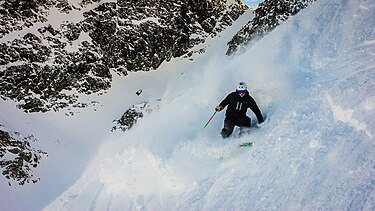
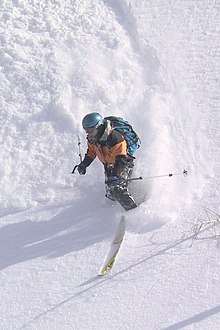
The powder skiing technique is a broad term with a wide range of sub-techniques. Powder skiing requires having equal balance from side to side to stay upright.
Alpine skiing techniques, used on groomed trails, can be modified for skiing in powder snow by lifting skis to create "float." [5] Accepted good forms include having knees bent and leaning backward into the ski boots.
While turning, the thigh and hip areas of a powder skier's legs act as shock absorbers. Each shock-absorbing turn in powder creates a rebound by pushing on the snow to slow down and releasing that force to speed up. This type of momentum control is the opposite of wide turns and cutting into the snow. Turning the skis in powder decreases speed and is also an opportunity to change the direction that the skis are pointing down the mountain. [6]
Using the Tip and Turn technique, one is less likely to get injured. [7] Begin by bouncing rhythmically in the snow while maintaining a straight trajectory. This bouncing causes one's leg muscles to flex and extend subconsciously. During the extension phase, the skis are pushed into the snow while they rise to the surface during flexion. Then they turn by raising one foot and tilting it towards the outer edge of the ski while keeping one's legs pressed together, and they repeat the process.
Leaning back in powder to maintain momentum and bring ski tips to the surface in deep snow can lead to discomfort. Shaped skis with wide front ends make the skis rise to the surface so that the skier does not have to lean back. [8]
The Dipsy Doodle is a technique that was developed in the late 1940s. [4] The "Dipsy Doodle" involves following the fall line and lifting each ski one at a time repeatedly, thus establishing float. The Dipsy Doodle is a trick maneuver popularized years ago by U.S. Olympian Dick Durrance. It has become a Wedeln (tail-wagging) exercise for many skiers. [9]

Modern powder ski construction is evolving with changes in optimal weight and durability. [10] [11] Powder skis use a design with wide tips and shorter tail lengths. [12]
Powder skis typically feature wide tips, ranging from 140 to 155 millimeters. The tails are slightly more tapered, often within a 125- to 140-millimeter range. This design helps powder skis remain buoyant in snow. The contours and proportions of a ski's tip, waist, and tail can vary among models. [13] [14]
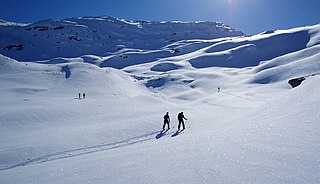
Cross-country skiing is a form of skiing whereby skiers traverse snow-covered terrain without use of ski lifts or other assistance. Cross-country skiing is widely practiced as a sport and recreational activity; however, some still use it as a means of travel. Variants of cross-country skiing are adapted to a range of terrain which spans unimproved, sometimes mountainous terrain to groomed courses that are specifically designed for the sport.

Snowboards are boards where the user places both feet, usually secured, to the same board. The board itself is wider than most skis, with the ability to glide on snow. Snowboards widths are between 6 and 12 inches or 15 to 30 centimeters. Snowboards are differentiated from monoskis by the stance of the user. In monoskiing, the user stands with feet inline with direction of travel, whereas in snowboarding, users stand with feet transverse to the longitude of the board. Users of such equipment may be referred to as snowboarders. Commercial snowboards generally require extra equipment, such as bindings and special boots which help secure both feet of a snowboarder, who generally ride in an upright position. These types of boards are commonly used by people at ski hills, mountains, backcountry, or resorts for leisure, entertainment, and competitive purposes in the activity called snowboarding.
A ski is a narrow strip of semi-rigid material worn underfoot to glide over snow. Substantially longer than they are wide, and characteristically employed in pairs, skis are attached to ski boots with ski bindings, with either a free, lockable, or partially secured heel. For climbing slopes, ski skins can be attached at the base of the ski.

Alpine skiing, or downhill skiing, is the pastime of sliding down snow-covered slopes on skis with fixed-heel bindings, unlike other types of skiing, which use skis with free-heel bindings. Whether for recreation or for sport, it is typically practiced at ski resorts, which provide such services as ski lifts, artificial snow making, snow grooming, restaurants, and ski patrol.

Snowshoes are specialized outdoor gear for walking over snow. Their large footprint spreads the user's weight out and allows them to travel largely on top of rather than through snow. Adjustable bindings attach them to appropriate winter footwear.
The parallel turn in alpine skiing is a method for turning which rolls the ski onto one edge, allowing it to bend into an arc. Thus bent, the ski follows the turn without sliding. It contrasts with earlier techniques such as the stem Christie, which slides the ski outward from the body ("stemming") to generate sideways force. Parallel turns generate much less friction and are more efficient both in maintaining speed and minimizing skier effort.
Ski boots are footwear used in skiing to provide a way to attach the skier to skis using ski bindings. The ski/boot/binding combination is used to effectively transmit control inputs from the skier's legs to the snow.

Alta is a ski area in the western United States, located in the town of Alta in the Wasatch Mountains of Utah, in Salt Lake County. With a skiable area of 2,614 acres (10.58 km2), Alta's base elevation is 8,530 ft (2,600 m) and rises to 11,068 ft (3,374 m) for a vertical gain of 2,538 ft (774 m). One of the oldest ski resorts in the country, it opened its first lift in early 1939. Alta is known for receiving more snow than most Utah resorts, with an average annual snowfall of 545 inches (13.8 m). It is also regularly ranked as having the best snow in North America. Alta is one of three remaining ski resorts in the U.S. that prohibits snowboarders, along with nearby competitor Deer Valley and Vermont's Mad River Glen.
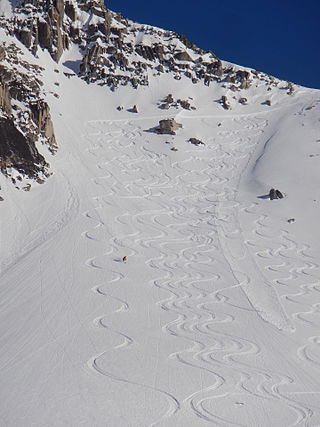
Backcountry skiing (US), also called off-piste (Europe), alpine touring, freeriding or out-of-area, is skiing in the backcountry on unmarked or unpatrolled areas either inside or outside a ski resort's boundaries. This contrasts with alpine skiing, which is typically done on groomed trails benefiting from a ski patrol. Unlike ski touring, backcountry skiing can – and often does – include the use of ski lifts including snowcats and helicopters. Recent improvements in equipment have increased the popularity of the sport. As the sport does confront the individual practicing it with the dangers of natural, unprepared alpine terrain like avalanches, it is generally recommended to carry standard safety equipment and to learn beforehand how to behave safely under such conditions.
Alf Marinius Engen was a Norwegian-American skier. He set several ski jumping world records during the 1930s and helped establish numerous ski areas in the Western United States. Engen is best known for his ski school at Alta in Utah and as the pioneer of powder skiing.
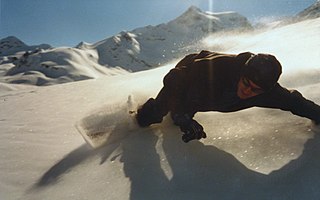
Freeriding is a style of snowboarding or skiing performed on natural, un-groomed terrain, without a set course, goals or rules. It evolved throughout the sport's formative years as a contrary response to the highly regimented style of ski competition prevalent at the time. Snowboarders primarily refer to freeriding as backcountry, sidecountry, or off-piste snowboarding, and sometimes big mountain or extreme riding.

Freeskiing, or new school skiing, is a specific type of alpine skiing, which involves tricks, jumps, and terrain park features, such as rails, boxes, jibs, or other obstacles. This form of skiing resulted from the growth of snowboarding combined with the progression of freestyle skiing. "Newschoolers", or those who specifically ski in this style, as opposed to traditional freestylers, freeriders, big mountain skiers, and racers, are often found in terrain parks, which are designed specifically for tricks.

A carved turn is a skiing and snowboarding term for the technique of turning by shifting the ski or snowboard onto its edges. When edged, the sidecut geometry causes the ski to bend into an arc, and the ski naturally follows this arc shape to produce a turning motion. The carve is efficient in allowing the skier to maintain speed because, unlike the older stem Christie and parallel turns, the skis do not create drag by sliding sideways.

Ski geometry is the shape of the ski. Described in the direction of travel, the front of the ski, typically pointed or rounded, is the tip, the middle is the waist and the rear is the tail. Skis have four aspects that define their basic performance: length, width, sidecut and camber. Skis also differ in more minor ways to address certain niche roles. For instance, skis for moguls are much softer to absorb shocks from the quick and sharp turns of the moguls and skis for powder are much wider to provide more "float" in deeper, softer snow.

Liberty Mountain Resort is a resort located in southern Pennsylvania. During the winter months the resort offers skiing, snowboarding, and snow tubing. The onsite hotel and lodge is open year-round and offers 114 rooms and multiple options for weddings and meetings. During the spring, summer, and fall the 18 hole Carroll Valley Golf Course at Liberty Mountain is open for a round of golf.
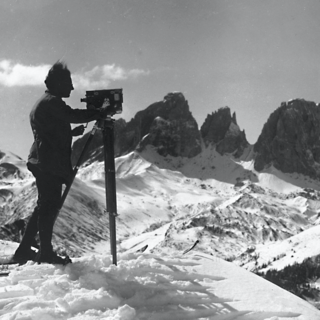
A ski film is a motion picture with sequences of expedition, recreation, competition, or acrobatic exhibition on snow skis. These non-fiction action sport films capture the experience of an athletic outdoor snow sporting culture. Ski films typically present one or more techniques, locations, or skiers. Categories include the feature, documentary of competition or other event coverage, instruction or technique demonstration, retrospective history, travel guide showcasing a region, or a short subject. More than 200 such videos debuted in 2006. Notable examples are listed at the Ski and Snowboard Film Institute, or have received awards from the International Ski Film Festival, X-Dance Action Sports Film Festival, IF3 International Freeski Film Festival, Cold Smoke Winter Film, Powder magazine, or similar.

Sylvain Saudan is an extreme skier, dubbed "skier of the impossible." He is noted for skiing down large and steep mountains, including those in the Himalayas, North America, Asia, Africa and Europe. In 1982, he entered the Guinness Book of World Records for descending the highest and steepest slope ever skied.

Line Skis, commonly shortened to Line or stylized as LINE, is a new school skis company owned by K2 Sports. Line Skis was founded by Jason Levinthal in 1995 to produce short, twin-tipped skis for freestyle skiers, and has since moved to produce full-length free skis.
Eric Pollard is an American snow freeskier and film editor from Welches, Oregon, who lives in the Hood River region of Oregon. He was a professional skier for Line Skis for over 22 years and now designs skis and snowboards for Season. He has always challenged the status quo by innovating outerwear, accessories, and hard goods for FW Apparel, Anon Optics, Dakine, K2, Causwell, and Hest.
This glossary of skiing and snowboarding terms is a list of definitions of terms and jargon used in skiing, snowboarding, and related winter sports.